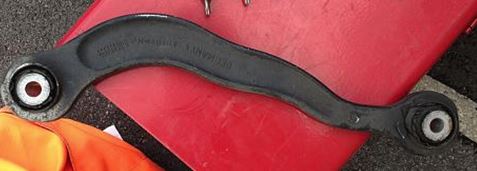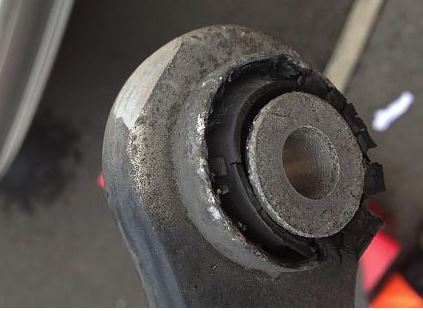WIS 35.30 Final Drive, Rear Drive Shafts: Difference between revisions
Ricebubbles (talk | contribs) |
(→Remove/install brake disc (rear axle): moved to brakes page) |
||
| (22 intermediate revisions by 2 users not shown) | |||
| Line 1: | Line 1: | ||
==Description - WIS 35.30 Final Drive, Rear Drive Shafts== | ==Description - WIS 35.30 Final Drive, Rear Drive Shafts== | ||
===Rear Drive/Axle Shafts=== | ===Rear Drive/Axle Shafts - Description=== | ||
The rear wheel carrier and bearing assembly was changed | The two types of W220 Rear Drive/Axle Shafts are shown together here. | ||
* The update | [[File:W220 Rear Axle Shaft Types.JPG|700px|center]] | ||
The rear wheel carrier and bearing assembly was changed to the splined or plug-in style with the introduction of the update W220, 2003 onward. | |||
* The update (2003 onward) W220 has Plug-in or Splined Rear Axle Shafts (No Inner Flange at Differential). | |||
[[File:W220_Plugin_Rear_Axle_Shafts.JPG|400px|center]] | [[File:W220_Plugin_Rear_Axle_Shafts.JPG|400px|center]] | ||
[[File:W220_with_AIRMATIC_Rear_Axle.JPG|600px|center]] | [[File:W220_with_AIRMATIC_Rear_Axle.JPG|600px|center]] | ||
* W220 (1999 – 2003) has Screwed Rear Axle Shafts ( | * W220 (1999 – 2003) has Screwed Rear Axle Shafts (6 bolt Inner Flange at Differential). | ||
[[File:W220_Screwed_Rear_Axle_Shafts.JPG|400px|center]] | [[File:W220_Screwed_Rear_Axle_Shafts.JPG|400px|center]] | ||
[[File:W220 Rear Axle Shaft Flange Style Inner CV.JPG|400px|center]] | [[File:W220 Rear Axle Shaft Flange Style Inner CV.JPG|400px|center]] | ||
'''TIP''' It can take 30-45 seconds of air tool ratcheting on the six inner cv joint to differential flange bolts to loosen them. This is due to the large amount of Loctite on the threads. You may even have to increase the air tool | '''TIP''' It can take 30-45 seconds of air tool ratcheting on the six inner cv joint to differential flange bolts to loosen them. This is due to the large amount of Loctite on the threads and the very high OEM installation torque. You may even have to increase the pressure supply to the air tool from the usual 90psi to 120psi to loosen these bolts. '''Be Warned''' quite often using a breaker bar and socket isn't successful. It helps to make sure the internal area of the bolt is clean to allow the socket full depth before applying torque. | ||
'''TIP''' Some W220 CV Joints don't have a circlip holding the inner CV Joint in place. Instead the joint is 'caulked' or 'staked' in place on the splined axle end with with three chisel impressions. Use a press to push the splined axle out of the cv-joint. When reinstalling re-stake the joint using a 5mm chisel. (WIS mentions 'caulking' new indentations 60 degrees offset from the original marks.) | '''TIP''' Some W220 CV Joints don't have a circlip holding the inner CV Joint in place. Instead the joint is 'caulked' or 'staked' in place on the splined axle end with with three chisel impressions. Use a press to push the splined axle out of the cv-joint. When reinstalling re-stake the joint using a 5mm chisel. (WIS mentions 'caulking' new indentations 60 degrees offset from the original marks.) | ||
[[File:W220 Rear Axle Shaft Flange Style Inner CV Stake Marks.JPG|400px|center]] | [[File:W220 Rear Axle Shaft Flange Style Inner CV Stake Marks.JPG|400px|center]] | ||
===Rear Drive/Axle Suspension=== | ===Rear Drive/Axle Suspension - Description=== | ||
For Rear Drive/Axle Suspension see [[Rear Drive/Axle Suspension|Rear Drive/Axle Suspension]] | |||
==Issues - Final Drive, Rear Drive Shafts== | ==Issues - Final Drive, Rear Drive Shafts== | ||
* The wheel bearings eventually become noisy and rough and need replacing. See DIY section below. | * The wheel bearings eventually become noisy and rough and need replacing. See DIY section below. | ||
* The rear axle suspension lower control arm bushing wear and develop a knocking noise on rough roads. See DIY section below. | |||
* The rubber boots protecting the inner and outer constant velocity (CV) joints on the rear axle shafts tear and allow water and dirt to penetrate. Replacement boots with grease are available. | * The rubber boots protecting the inner and outer constant velocity (CV) joints on the rear axle shafts tear and allow water and dirt to penetrate. Replacement boots with grease are available. | ||
==Part Numbers - Inner CV Boot== | * If the inside of the rear tyres have worn badly, eg have worn right through the steel wires, whilst the outside of the tyres are fine, this can indicate failed rear suspension parts. | ||
* Rear wheel not centered in wheel arch. This can be due to badly worn Rear Camber Strut Bushes. | |||
[[File:W220 Example of Worn Rear Camber Strut 00.JPG|500px|center]] | |||
* Rear Camber Strut Bushes will wear and eventually need replacing. | |||
[[File:W220 Example of Worn Rear Camber Strut 01.JPG|500px]] | |||
[[File:W220 Example of Worn Rear Camber Strut 02.JPG|500px]] | |||
==Part Numbers - Final Drive, Rear Drive Shafts== | |||
===Inner CV Boot - Part Numbers=== | |||
* M-B 220 350 00 37 or 2203500037. The M-B kit 2203500037 comes with 120 grams of grease, the boot, bolts, axle nut and the boot band clamps. | * M-B 220 350 00 37 or 2203500037. The M-B kit 2203500037 comes with 120 grams of grease, the boot, bolts, axle nut and the boot band clamps. | ||
* Febi Bilstein Genuine Brand New CV Boot 30965. | * Febi Bilstein Genuine Brand New CV Boot 30965. | ||
[[File:Febi Bilstein Genuine Brand New CV Boot 30965.JPG|400px|center]] | [[File:Febi Bilstein Genuine Brand New CV Boot 30965.JPG|400px|center]] | ||
==DIY Replacement - Rear Wheel Bearings== | ==DIY Replacement - Final Drive, Rear Drive Shafts== | ||
===Relevance=== | |||
===Rear Axle Shaft Inner CV - DIY Replacement=== | |||
G-AMG has posted an excellent Photo DIY- Rear Axle "Half-Shaft"/CV Axle R/R which also applies to the W220 [http://www.benzworld.org/forums/w140-s-class/2116906-photo-diy-rear-axle-half-shaft.html]. It includes the method for disassembling a CV joint. | |||
===Rear Axle Suspension Lower Control Arm Bushings - DIY Replacement=== | |||
[[Rear Drive/Axle Suspension]] | |||
===Rear Camber Strut Bushes - DIY Replacement=== | |||
See posting by BenzWorld member wasimgehlen, [http://www.benzworld.org/forums/w220-s-class/1659069-s500-w220-rear-wheel-alignment.html] | |||
===Rear Wheel Bearings - DIY Replacement=== | |||
====Relevance==== | |||
This document is relevant to my 2003 (Update) W220 S500L (Long Wheel Base Sedan) Chassis Number: 220.175, Engine Number: 113.960, Transmission: 9-speed (722.901) (7 forward and 2 reverse gears). | This document is relevant to my 2003 (Update) W220 S500L (Long Wheel Base Sedan) Chassis Number: 220.175, Engine Number: 113.960, Transmission: 9-speed (722.901) (7 forward and 2 reverse gears). | ||
| Line 98: | Line 63: | ||
This article outlines how to remove the rear wheel carriers, leaving the rear axle shafts still connected to the differential. | This article outlines how to remove the rear wheel carriers, leaving the rear axle shafts still connected to the differential. | ||
===References=== | ====References==== | ||
* WIS Document: ar35.20-p-0115i “Remove/install wheel carrier” | * WIS Document: ar35.20-p-0115i “Remove/install wheel carrier” | ||
| Line 107: | Line 72: | ||
<br clear=all> | <br clear=all> | ||
===Acknowledgement=== | ====Acknowledgement==== | ||
Thanks to BenzWorld Member cudaized. | Thanks to BenzWorld Member cudaized. | ||
===Method for Removing Old Bearing=== | ====Method for Removing Old Bearing==== | ||
* Place car on secure jack stands and remove both rear wheels. | * Place car on secure jack stands and remove both rear wheels. | ||
* Open Indent Catch for Rear Axle Collar Nut. | * Open Indent Catch for Rear Axle Collar Nut. | ||
| Line 127: | Line 92: | ||
* Release Parking Brake | * Release Parking Brake | ||
* Relax Parking Brake Cable Automatic Tensioning Mechanism. It took me several attempts to get this right. The trick is to rotate the detent eccentric bolt (g) counter clockwise when viewed from underneath until it clicks into place into the hold down clip spring (d). | * Relax Parking Brake Cable Automatic Tensioning Mechanism. See also [[WIS 42.20 Parking Brake]]. It took me several attempts to get this right. The trick is to rotate the detent eccentric bolt (g) counter clockwise when viewed from underneath until it clicks into place into the hold down clip spring (d). | ||
[[File:W220_Relax_Parking_Brake_Cable_Automatic_Tensioning_Mechanism.JPG|700px|center]] | [[File:W220_Relax_Parking_Brake_Cable_Automatic_Tensioning_Mechanism.JPG|700px|center]] | ||
| Line 167: | Line 132: | ||
* Release Automatic Parking Brake Mechanism. | * Release Automatic Parking Brake Mechanism. | ||
* Adjust the parking brake shoes to provide maximum clearance. For access to the parking brake thumbwheel (ratchet mechanism) rotate the right side wheel so that the access hole (any wheel bolt hole) is positioned at 11:00 o’clock position. (For the left side wheel the access hole (wheel bolt hole) is positioned at the 1:00 o’clock position. Note also the correct angle for the wide bladed screw driver tip. | * Adjust the parking brake shoes to provide maximum clearance. See also [[WIS 42.20 Parking Brake]]. For access to the parking brake thumbwheel (ratchet mechanism) rotate the right side wheel so that the access hole (any wheel bolt hole) is positioned at 11:00 o’clock position. (For the left side wheel the access hole (wheel bolt hole) is positioned at the 1:00 o’clock position. Note also the correct angle for the wide bladed screw driver tip. | ||
[[File:W220_Adjust_the_parking_brake_shoes.JPG|400px|center]] | [[File:W220_Adjust_the_parking_brake_shoes.JPG|400px|center]] | ||
| Line 269: | Line 234: | ||
[[File:W220_Wheel_Carrier_Disassembled.JPG|300px|center]] | [[File:W220_Wheel_Carrier_Disassembled.JPG|300px|center]] | ||
===Method For Installing New Bearing=== | ====Method For Installing New Bearing==== | ||
* New Rear Wheel Bearing. | * New Rear Wheel Bearing. | ||
[[File:W220_New_Rear_Wheel_Bearing.JPG|300px|center]] | [[File:W220_New_Rear_Wheel_Bearing.JPG|300px|center]] | ||
| Line 291: | Line 256: | ||
[[File:W220_Rear_Axle_Shaft_Flange_Reinstalled_in_Wheel_Carrier.JPG|400px|center]] | [[File:W220_Rear_Axle_Shaft_Flange_Reinstalled_in_Wheel_Carrier.JPG|400px|center]] | ||
===An Alternative Method for Installing New Bearing=== | ====An Alternative Method for Installing New Bearing==== | ||
* See referenced BMW video. If no hydraulic press is available use a large plumber’s flange plate with several large washers, a puller, nut and bolt (thread size 5/8” UNF). | * See referenced BMW video. If no hydraulic press is available use a large plumber’s flange plate with several large washers, a puller, nut and bolt (thread size 5/8” UNF). | ||
[[File:Large_plumber’s_flange_plate.JPG|300px|center]] | [[File:Large_plumber’s_flange_plate.JPG|300px|center]] | ||
| Line 367: | Line 332: | ||
* Reinstall Wheel Carrier into Vehicle. | * Reinstall Wheel Carrier into Vehicle. | ||
===Reinstalled Wheel Carrier, New Discs and Brake Pads=== | ====Reinstalled Wheel Carrier, New Discs and Brake Pads==== | ||
[[File:W220_Reinstalled_Wheel_Carrier,_New_Discs_and_Brake_Pads.JPG|400px|center]] | [[File:W220_Reinstalled_Wheel_Carrier,_New_Discs_and_Brake_Pads.JPG|400px|center]] | ||
| Line 393: | Line 358: | ||
[[File:W220_Stake_the_Axle_Collar_Nuts.JPG|300px|center]] | [[File:W220_Stake_the_Axle_Collar_Nuts.JPG|300px|center]] | ||
===Adjust Parking Brake Thumbwheel= | ====Adjust Parking Brake Thumbwheel==== | ||
See [[parking brake]] page. | |||
Latest revision as of 14:25, 28 July 2021
Description - WIS 35.30 Final Drive, Rear Drive Shafts
Rear Drive/Axle Shafts - Description
The two types of W220 Rear Drive/Axle Shafts are shown together here.

The rear wheel carrier and bearing assembly was changed to the splined or plug-in style with the introduction of the update W220, 2003 onward.
- The update (2003 onward) W220 has Plug-in or Splined Rear Axle Shafts (No Inner Flange at Differential).
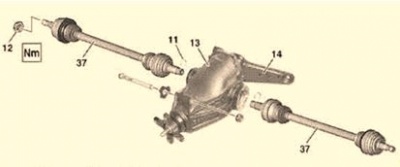
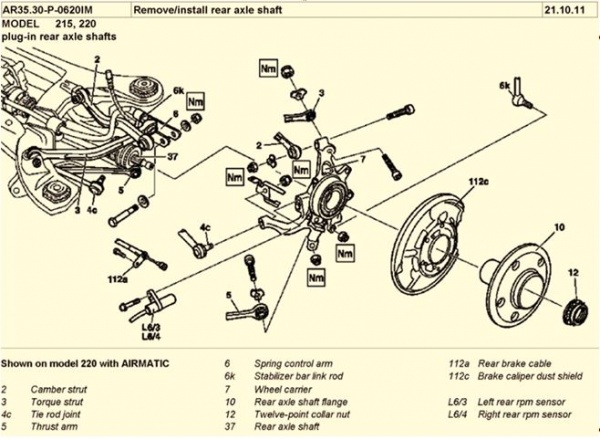
- W220 (1999 – 2003) has Screwed Rear Axle Shafts (6 bolt Inner Flange at Differential).
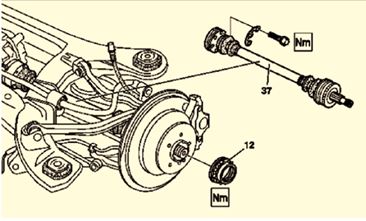
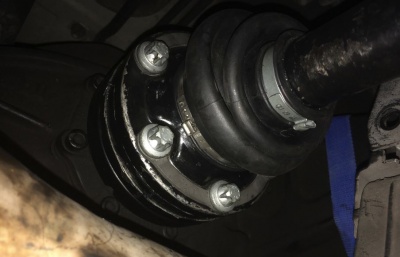
TIP It can take 30-45 seconds of air tool ratcheting on the six inner cv joint to differential flange bolts to loosen them. This is due to the large amount of Loctite on the threads and the very high OEM installation torque. You may even have to increase the pressure supply to the air tool from the usual 90psi to 120psi to loosen these bolts. Be Warned quite often using a breaker bar and socket isn't successful. It helps to make sure the internal area of the bolt is clean to allow the socket full depth before applying torque.
TIP Some W220 CV Joints don't have a circlip holding the inner CV Joint in place. Instead the joint is 'caulked' or 'staked' in place on the splined axle end with with three chisel impressions. Use a press to push the splined axle out of the cv-joint. When reinstalling re-stake the joint using a 5mm chisel. (WIS mentions 'caulking' new indentations 60 degrees offset from the original marks.)
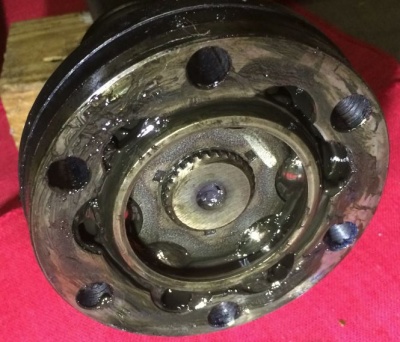
Rear Drive/Axle Suspension - Description
For Rear Drive/Axle Suspension see Rear Drive/Axle Suspension
Issues - Final Drive, Rear Drive Shafts
- The wheel bearings eventually become noisy and rough and need replacing. See DIY section below.
- The rear axle suspension lower control arm bushing wear and develop a knocking noise on rough roads. See DIY section below.
- The rubber boots protecting the inner and outer constant velocity (CV) joints on the rear axle shafts tear and allow water and dirt to penetrate. Replacement boots with grease are available.
- If the inside of the rear tyres have worn badly, eg have worn right through the steel wires, whilst the outside of the tyres are fine, this can indicate failed rear suspension parts.
- Rear wheel not centered in wheel arch. This can be due to badly worn Rear Camber Strut Bushes.
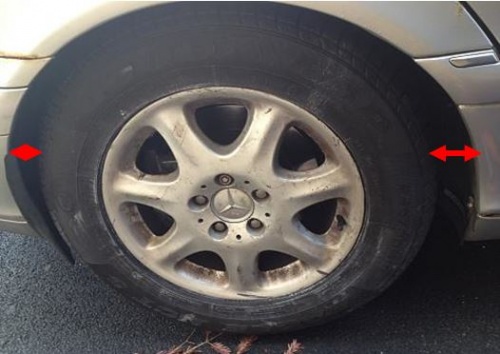
- Rear Camber Strut Bushes will wear and eventually need replacing.
Part Numbers - Final Drive, Rear Drive Shafts
Inner CV Boot - Part Numbers
- M-B 220 350 00 37 or 2203500037. The M-B kit 2203500037 comes with 120 grams of grease, the boot, bolts, axle nut and the boot band clamps.
- Febi Bilstein Genuine Brand New CV Boot 30965.
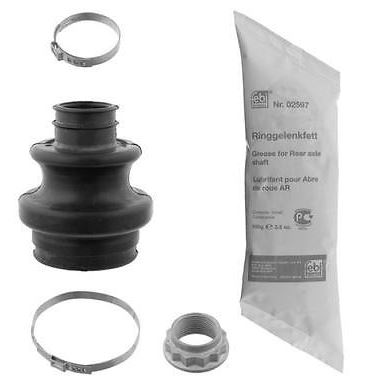
DIY Replacement - Final Drive, Rear Drive Shafts
Rear Axle Shaft Inner CV - DIY Replacement
G-AMG has posted an excellent Photo DIY- Rear Axle "Half-Shaft"/CV Axle R/R which also applies to the W220 [1]. It includes the method for disassembling a CV joint.
Rear Axle Suspension Lower Control Arm Bushings - DIY Replacement
Rear Camber Strut Bushes - DIY Replacement
See posting by BenzWorld member wasimgehlen, [2]
Rear Wheel Bearings - DIY Replacement
Relevance
This document is relevant to my 2003 (Update) W220 S500L (Long Wheel Base Sedan) Chassis Number: 220.175, Engine Number: 113.960, Transmission: 9-speed (722.901) (7 forward and 2 reverse gears).
The referenced videos refer to a BMW 5 Series. They were a very good guide as to what was required in general terms to replace rear wheel bearings on a Mercedes-Benz W220.
However Be Warned! DIY replacement of rear wheel bearings in an Update 2003 W220 is NOT as straight forward as the video shows.
Reference WIS, W220’s have two styles of rear axle shafts. (See Section Rear Wheel Carrier and Bearing Assembly.) Early models have an inner flange on the differential onto which the rear axle shafts bolt. The referenced BMW videos are more compatible with this style of rear axle shaft. My update W220 has a newer style rear axle shaft without a flange plate. Consequently it is not possible to remove the rear axle shafts without some major dismantling. Fortunately this is not required to replace the rear wheel bearings. However the rear wheel carriers must be removed.
This article outlines how to remove the rear wheel carriers, leaving the rear axle shafts still connected to the differential.
References
- WIS Document: ar35.20-p-0115i “Remove/install wheel carrier”
Acknowledgement
Thanks to BenzWorld Member cudaized.
Method for Removing Old Bearing
- Place car on secure jack stands and remove both rear wheels.
- Open Indent Catch for Rear Axle Collar Nut.
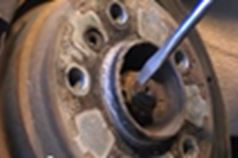
- Soak Axle Thread With Penetrene.
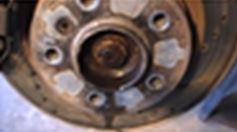
- While you are at it soak every likely bolt and nut that needs removing with Penetrene.
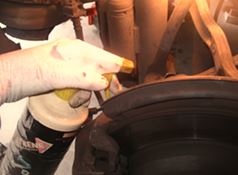
- Prevent Disk From Rotating
On the BMW in the referenced video an Allan Key was jammed against the brake calliper. On M-B W220 apply the parking brake.
- Undo Rear Wheel Axle Collar Nut (32mm 12 point socket) with a large breaker bar. This requires a huge amount of effort as the nut is torqued to 350Nm.
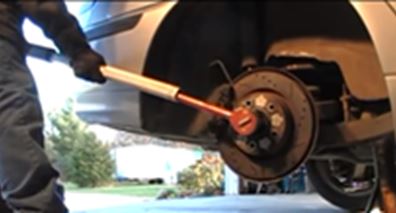
- Release Parking Brake
- Relax Parking Brake Cable Automatic Tensioning Mechanism. See also WIS 42.20 Parking Brake. It took me several attempts to get this right. The trick is to rotate the detent eccentric bolt (g) counter clockwise when viewed from underneath until it clicks into place into the hold down clip spring (d).

- Unplug Brake Wear Sensor. My W220 has the rear brake wear sensor on the rear right side wheel only.
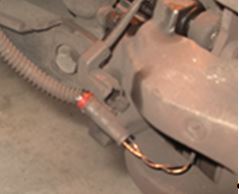
- Remove Brake Wear Sensor Bracket.
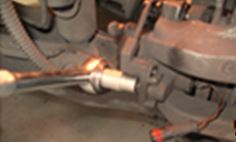
- Remove Rear Wheel Speed Sensor.
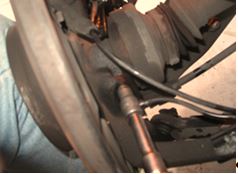
- Undo Nut on Tie Rod Ball Joint.
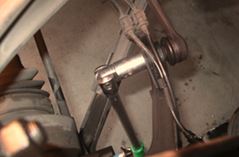
- Protect Brake Wear and Wheel Speed Sensors. Ensure brake wear and wheel speed sensors are placed out of the way so that they do not get damaged.
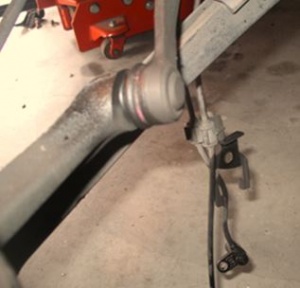
- Protect Tie Rod Ball Joint Rubber Boot. Prise back the rubber boot on the tie rod ball joint to expose the inner cone to avoid damaging the rubber boot with the ball joint separator.
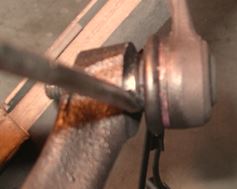
- Use Ball Joint Separator to Remove Tie Rod Ball Joint. Be warned the tie rod ball joint can release with a loud bang. It is a good idea to gently tap around the tie rod ball joint socket with a small hammer while it is under increasing tension.
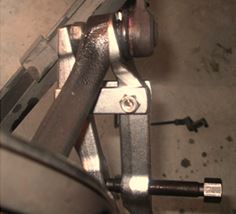
- Protect the Ball Joint Thread. Screwing a nut onto the ball joint thread protects the thread and also prevents the ball joint from flying apart. Ensure the nut is flush with the end of the thread for protection of the thread.
Also avoid damaging the rubber boot with the ball joint separator forked tongue.
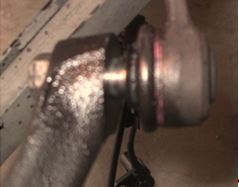
- Remove Brake Calliper Bolts. Use a 16mm ring or combination spanner on the brake calliper bolts.
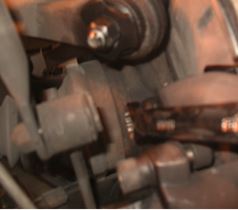
- I tap the end of the combination spanner with a rubber mallet to start the bolt undoing.
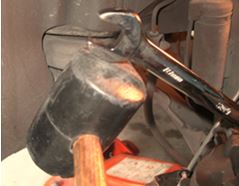
- Remove Brake Calliper. Suspend the brake calliper with wire so that the brake hose is not crimped or damaged.
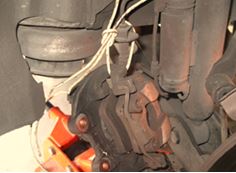
- Release Automatic Parking Brake Mechanism.
- Adjust the parking brake shoes to provide maximum clearance. See also WIS 42.20 Parking Brake. For access to the parking brake thumbwheel (ratchet mechanism) rotate the right side wheel so that the access hole (any wheel bolt hole) is positioned at 11:00 o’clock position. (For the left side wheel the access hole (wheel bolt hole) is positioned at the 1:00 o’clock position. Note also the correct angle for the wide bladed screw driver tip.
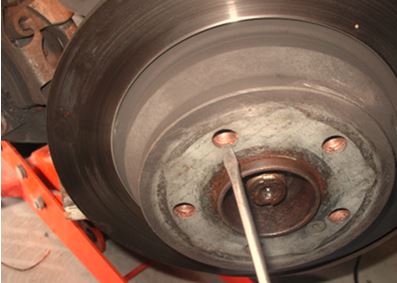
- Internal View of Parking Brake Thumbwheel. This is what you are trying to do. Rotate the parking brake thumbwheel (ratchet mechanism) downwards (screw driver handle upwards) to release the brake to its maximum clearance.
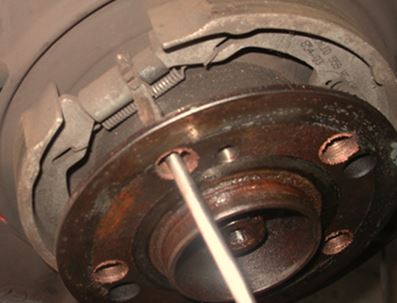
- Remove Brake Disk. Remove the Torx screw holding brake disk to rear axle shaft flange.
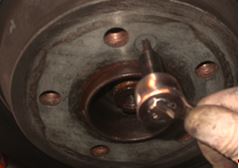
- If you haven’t previously used anti-seize grease on the hub you may have to tap the disc with a rubber mallet.
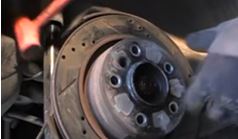
- Remove the Parking Brake Lower Retracting Spring. This requires a fair bit of effort but it is possible with normal 45º long nose pliers.
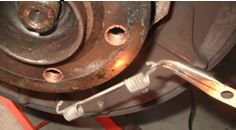
- Remove the Brake Shoe Retaining Springs. Remove the two rear brake shoe retaining springs by pushing them inwards and twisting 90º.
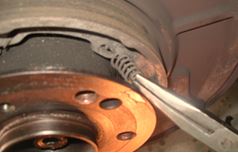
- Note the Retaining Springs Alignment for Re-installation. The installed position of the retaining springs is such that the hook end is facing radially inwards and pointing directly at the centre of the wheel hub.
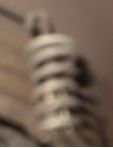
- Remove the Parking Brake Shoes and Adjusting Mechanism over the Wheel Hub.
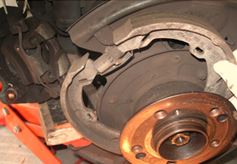
- Note the Orientation of the Parking Brake Adjusting Thumbwheel. The thrust piece (shorter length) is towards the front of the vehicle on both sides. This is the right side wheel.
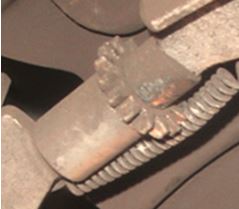
- The diagram in WIS shows the left side wheel with the thrust piece (c) (shorter length) on the left facing towards the front of the vehicle.
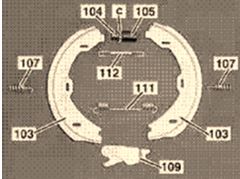
- Store the Parking Brake. Store the parking brake out of the way maintaining the correct positioning for each component to aid in re-installation.
- Remove the Parking Brake Expansion Lock. Carefully remove the parking brake expansion lock (actuating mechanism) and note the orientation. The hooked end of the Expansion Lock (109) is towards the front of the vehicle on both sides. This is the right side wheel.
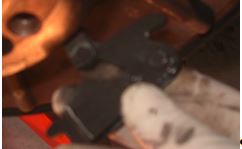
- WIS shows the left side wheel.

- Remove the Parking Brake Cable. Remove the bolt and withdraw the parking brake cable and place out of the way.
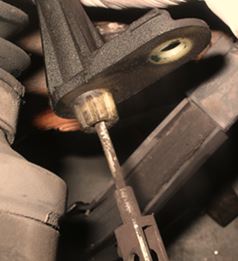
- Completely Remove Axle Collar Nut
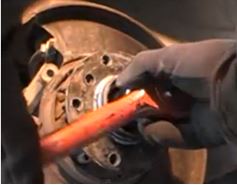
- Prepare to Remove Outer Axle Shaft Flange. Ensure that rear axle shaft spline is loose in the outer axle shaft flange before doing any more steps. If it is not loose, use an appropriate bearing puller to apply pressure to the axle shaft spline (place the nut back on and do it up flush with the end to protect the thread). Once the axle shaft is free it will move longitudinally several cms.
Install a bearing separator tool for two or three wheel lug bolts to push against. A splitter/separator tool is available on line for less than $70.
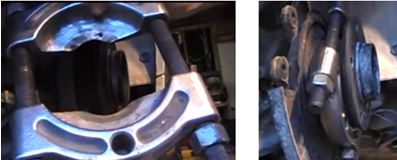
- I used my hydraulic jack to raise the rear wheel carrier so that the axle shaft was horizontal. Tighten two or three wheel lug bolts evenly to remove the outer axle shaft flange. Tap the axle shaft flange with a hard rubber mallet to assist breaking the joint. Be warned, it may release with a loud bang.
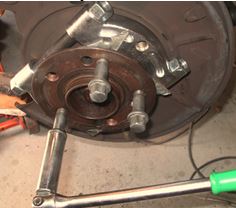
- Remove Rear Axle Shaft Flange. On my W220 I did not remove the rear axle shaft flange completely at this stage. It still had about 50% remaining which I pressed out after complete removal of the wheel carrier.
Note the bearing has separated into several pieces and the outer shell is firmly attached to the rear axle shaft flange. This image is from the BMW video and shows the bearing red seal which has also separated.
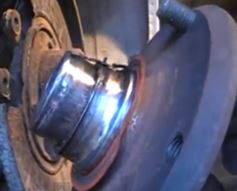
- Remove all the Wheel Carrier Linkages, Struts and Arms.
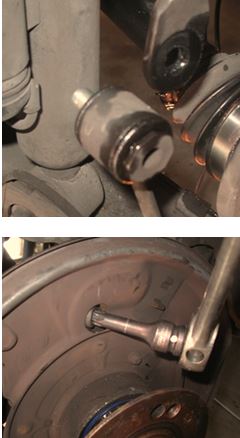
- As I dismantle items, I either reinsert the bolts and nuts or tape them to the relevant components ready for re-installation. This ensures that I use the correct parts and get the correct orientation.
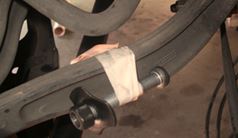
- Eventually the whole wheel carrier can be removed.
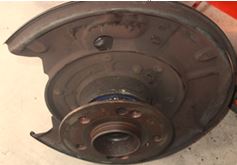
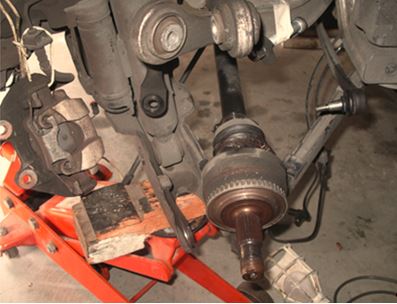
- Note also I have undone the inner and outer rubber boots on both rear axle shafts and re-greased the constant velocity joints. I used hose clamps with RTV Silicon sealer on re-installation and copper anti-seize grease which I use on just about everything.
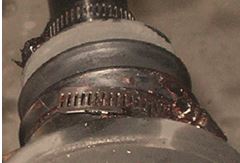
- Complete Removal of Wheel Flange from Wheel Carrier. Now completely remove the wheel flange from the wheel carrier. Place the bearing separator around the rear axle flange and support it in an hydraulic press.
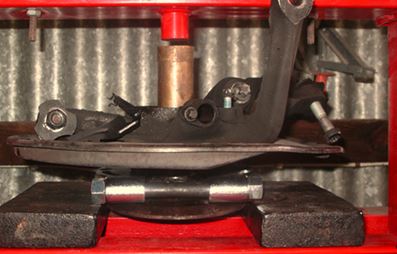
- Use a spacer with a diameter matching the axle flange diameter and press the axle flange out of the bearing. It doesn’t matter if the bearing is damaged as it is being replaced anyway.
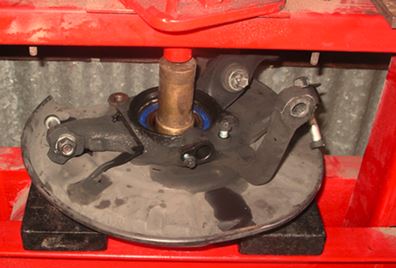
- Note the bearing has separated into two pieces and one of the outer shells is firmly attached to the rear axle shaft flange.
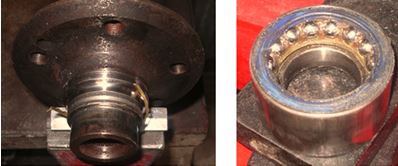
- Remove the Outer Bearing Shell. Carefully grind a channel through the bearing shell on the rear axle shaft flange. Be careful not to damage the surface of the rear axle shaft flange. It is not necessary to grind all the way through as the grinding process heats the bearing shell and expands it. Once only a small thickness remains, the bearing shell usually pops open on its own.
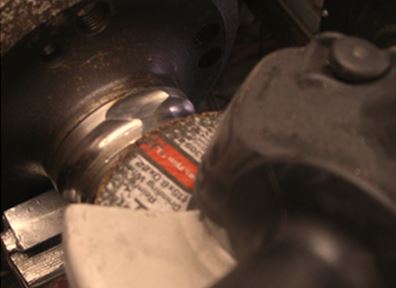
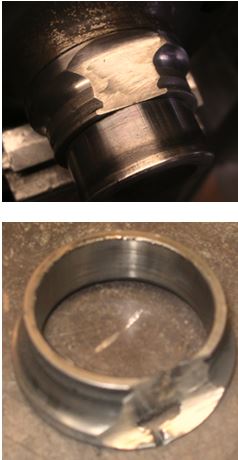
- Remove the Brake Dust Shield
- Remove Bearing Snap Ring (Cir-Clip). Before the bearing can be removed, the securing cir-clip must be removed from the rear wheel carrier. This turned out to be more of a challenge than I envisaged. My cir-clip pliers would not budge the cir-clip. On the W220 it is a substantial piece of metal and is about 2mm thick.
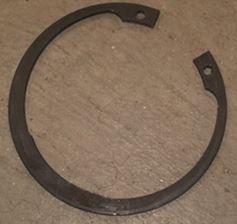
- I fashioned a cir-clip retractor out of some scrap nuts and bolts and was able to remove and reinsert the cir-clip in a very controlled fashion.
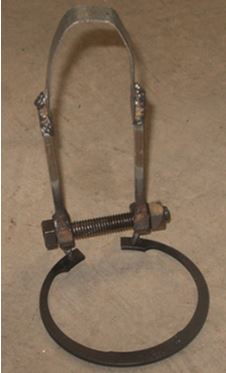
- Remove Rear Wheel Bearing. Press out the rear wheel bearing. I used a short length of 100mm bore casing as a spacer to support the wheel carrier.
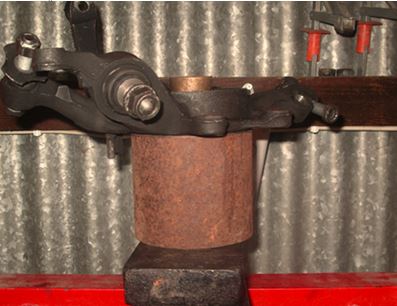
- A large washer was used to transfer the force from the press to the outer diameter of the bearing. The bearing pressed out very easily.
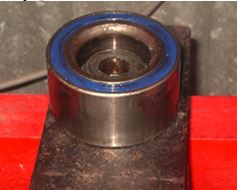
- Wheel Carrier Disassembled. There was a slight amount of bruising on the outer edges of the wheel carrier but nothing on any critical surface. The damage was easily cleaned up with a file.
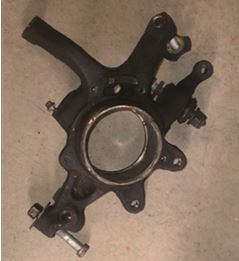
Method For Installing New Bearing
- New Rear Wheel Bearing.
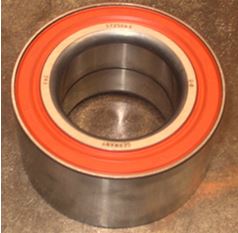
- Apply Anti-Seize to Bearing Housing.
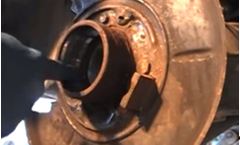
- Prepare Installation Tools. I used a ¾” plumbing flange as the bearing support washer. It was placed on the press with the old bearing acting as a spacer for additional clearance. Use a large washer matching the diameter of the bearing to press the new bearing fully into place. It is important to use the correct diameter spacers so that the force of the press is mostly applied to the outer shell of the bearing.
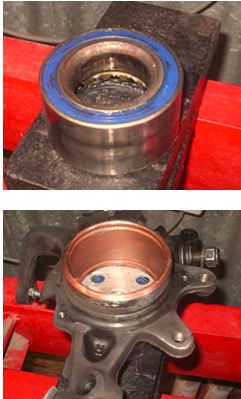
- Reinstall the Cir-Clip.
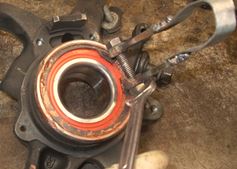
- Reinstall the Brake Dust Shield.
- Reinstall the Wheel Flange into the Wheel Carrier. This time it is important that the force of the press is applied to the inner bearing race. I fashioned a heavy duty washer of the correct diameter and used the old bearing race as a spacer to support the wheel carrier in the press. The ¾” plumbing flange and the old bearing provided the sufficient clearance.
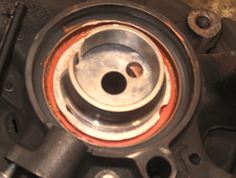
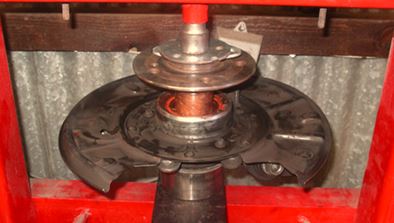
- Rear Axle Shaft Flange Reinstalled in Wheel Carrier. The rear axle shaft flange surface is flush with the internal bearing surface.
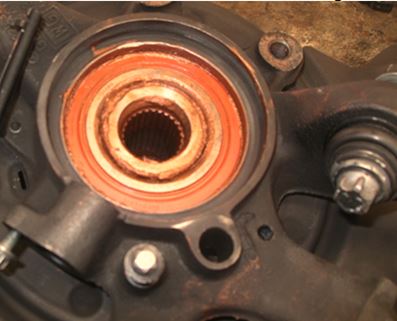
An Alternative Method for Installing New Bearing
- See referenced BMW video. If no hydraulic press is available use a large plumber’s flange plate with several large washers, a puller, nut and bolt (thread size 5/8” UNF).
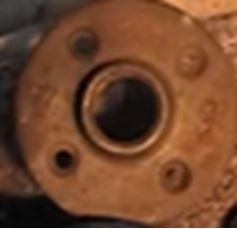
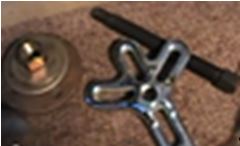
- Place Flange, Washers and Nut at back of Bearing Housing.
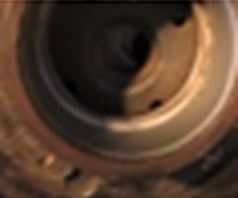
- Install Puller at Front of Bearing Housing.
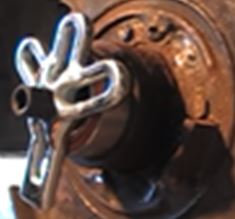
- Screw In New Bearing Until Puller Meets Housing.
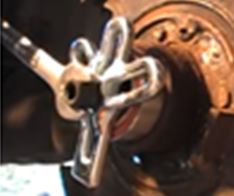
- Use Mallet to Ensure Even Pressure on Bearing (No Cocking).
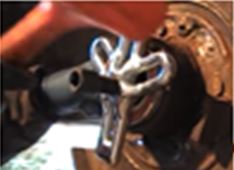
- Once Puller Meets Housing Reverse Puller and Use Washer on Front Edge of Bearing.
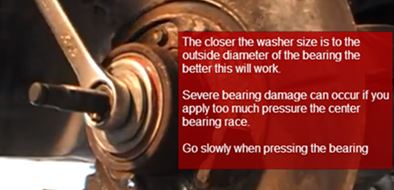
- Apply a Small Amount of Tension and Tap With Mallet.
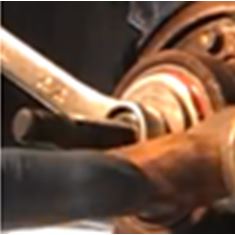
- New Bearing Fully Seated Into Wheel Carrier.
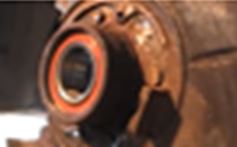
- Install new Snap Ring (Cir-Clip). The BMW video makes this look easy!
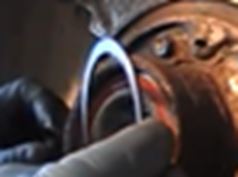
- Reinstall Parking Brake.
- Add Anti-Seize To Inside Surface of Bearing.
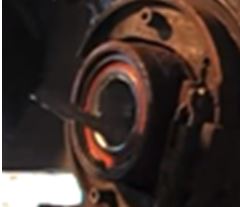
- Prepare Plumbing Flange, Washers and Bolt.
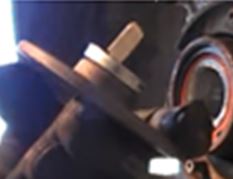
- Place Through Wheel Carrier From Back.
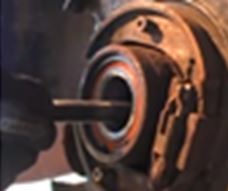
- Place Rear Axle Shaft Flange Over Puller Bolt from Front.
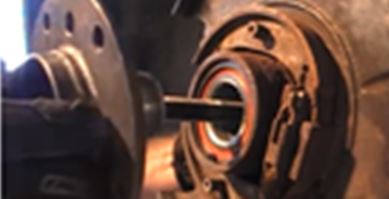
- Use Washer and Nut to Press Rear Axle Shaft Flange Into Wheel Carrier Housing.
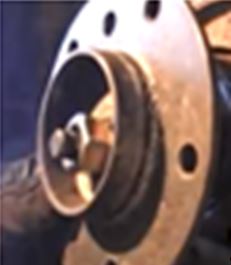
- Screw Rear Axle Shaft Flange Into Wheel Carrier Housing.
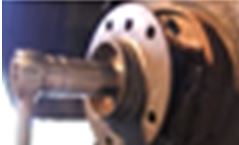
- Place Wheel carrier on Axle Shaft and Reinstall (E14).
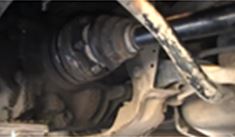
- Apply Anti-Seize to Rear Axle Shaft Flange Face.
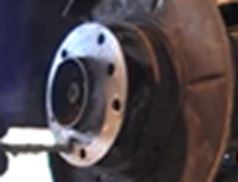
- Reinstall Disk Rotor with Screw.
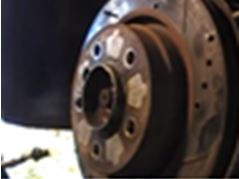
- Use Mallet to Ensure Even Seating of Disk Rotor.
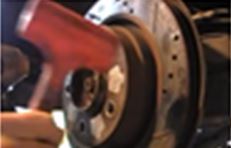
- Reinstall Brake Calliper.
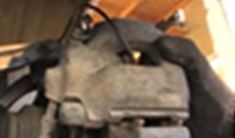
- Apply Anti-Sieze to Axle Thread.
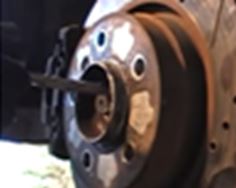
- Prevent Rotor From Turning With Allan Key or Parking Brake and Torque Axle Collar nut (350Nm).
- Stake Axle Collar Nut Locking Mechanism.
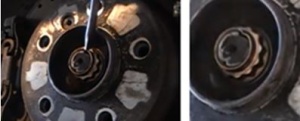
- Reinstall Sway Bar (Both Sides).
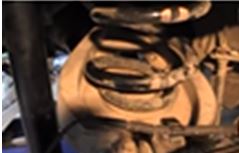
- Reinstall Wheel Carrier into Vehicle.
Reinstalled Wheel Carrier, New Discs and Brake Pads
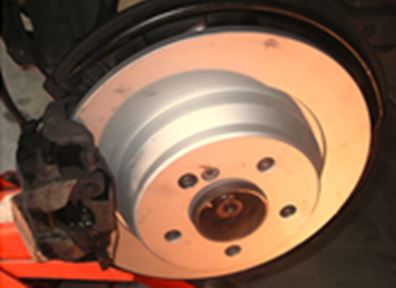
- Reinstall Axle Collar Nuts. These are one use only and must be replaced each time.
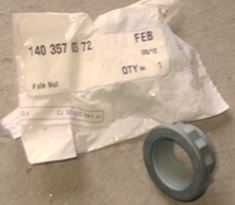
- Torque Required is 350 Nm. 350 Nm is way beyond the maximum capability of my torque wrench so I used my own weight and my breaker bar.
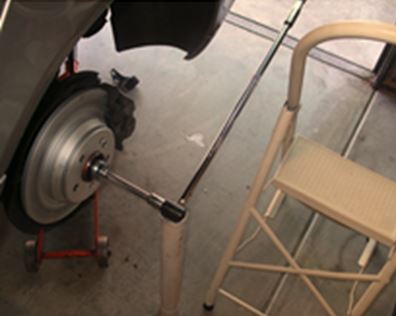
- To achieve 350 Nm torque requires my 94Kg weight to be applied at 380mm.
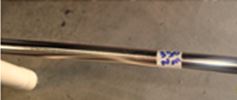
- Torque Calculation.
- Torque [Nm]/(Weight [Kg]x g [m/s2]) = Distance [m]
- The Earth’s Gravitational Constant, g = 9.8 [m/s2])
- So for T = 350 Nm,
- W = 94 Kg
- Then D = 350/(94 x 9.8) = 0.38m
- Torque Axle Collar Nuts. I smoothly applied my 94Kg weight at the 0.38m mark on the breaker bar, without jumping. The breaker bar was supported at the fulcrum point with a length of hard plastic pipe.
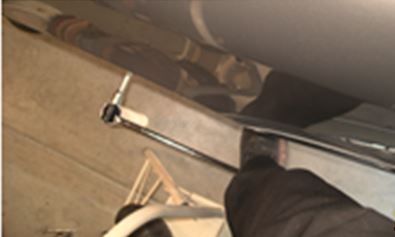
- Axle Collar Nut Torque ‘Calibration’. I tested my weight torqueing method using the old axle collar nut and then tried removing it as I had done originally. It seemed about the same amount of effort required, ie the nut took almost as much force as I could muster to lift the end of my breaker bar to undo the 350 Nm collar nut.
- Stake the Axle Collar Nuts. Even though the original axle nuts were not staked in place I decided to do so just for added security.
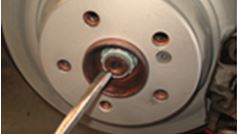
Adjust Parking Brake Thumbwheel
See parking brake page.
